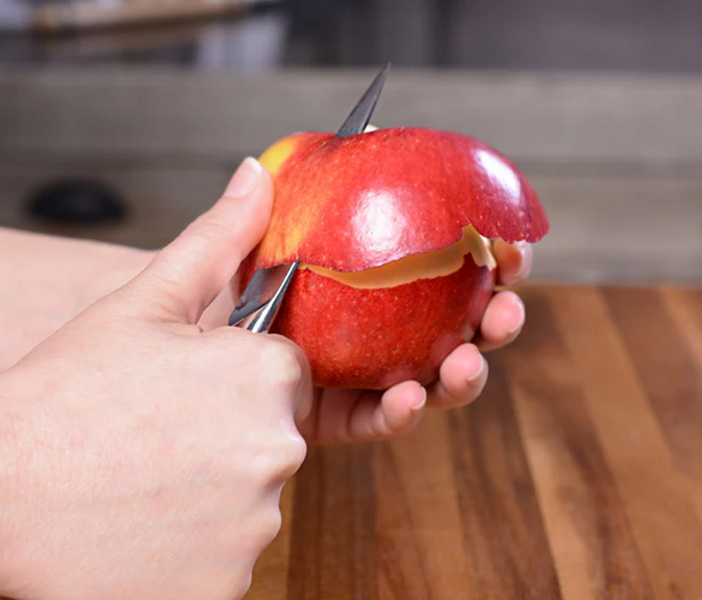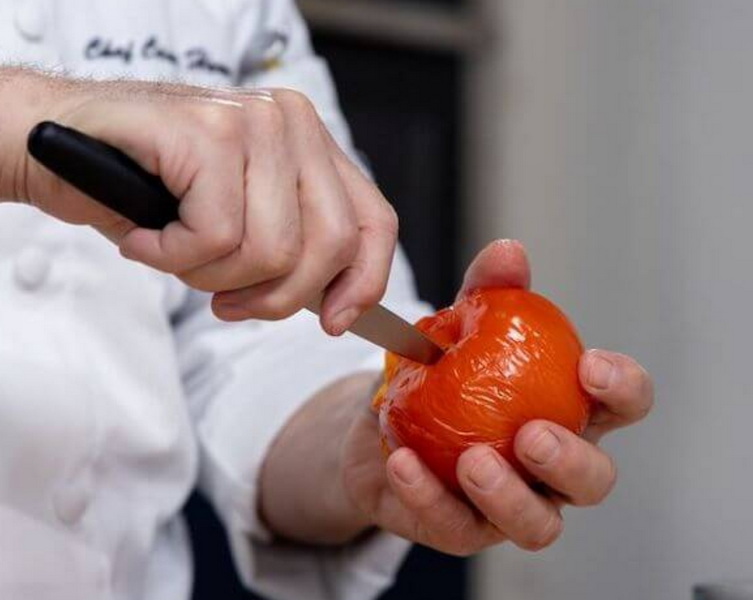- All
- Product Name
- Product Keyword
- Product Model
- Product Summary
- Product Description
- Multi Field Search
Views: 222 Author: Ann Publish Time: 2025-10-21 Origin: Site











Content Menu
>> 1. Straight Edge Paring Knife
>> 3. Bird's Beak (or Curved) Paring Knife
● How to Choose a Paring Knife Based on Your Cooking Style
● Maintenance Tips for Paring Knives
● How to Use a Paring Knife Safely
● Why Choose Our Paring Knives?
● Frequently Asked Questions (FAQs)
>> 1. What tasks are best suited for a paring knife?
>> 2. How do I maintain sharpness on my paring knife?
>> 3. Can a paring knife be used for cutting meat?
>> 4. What is the difference between a paring knife and a utility knife?
>> 5. Are ceramic paring knives better than steel?
Choosing the perfect paring knife is essential for precision and efficiency in your kitchen. Whether you're a home cook or a professional chef, the right paring knife can make tasks like peeling, trimming, and detailed cutting effortless and safe.

A paring knife is a small, versatile knife with a plain edge blade typically 2.5 to 4 inches long, designed for intricate tasks such as peeling fruits and vegetables, deveining shrimp, or cutting small garnishes. Its size and control make it the go-to tool for precision work.
Paring knives are often overlooked but are indispensable in everyday kitchen tasks that require more control than a chef's knife can provide. They allow for delicate work, such as removing seeds or cutting decorative garnishes, where precision is paramount.
Choosing the right paring knife involves understanding the different blade styles:
This is the classic all-purpose paring knife suitable for peeling and slicing thin pieces. The straight edge provides clean cuts on soft produce. It's especially useful for tasks that require straight, controlled slicing such as cutting fruits like apples or pears.
Featuring a small scalloped edge, this knife excels at cutting through items with tough skins and soft interiors like tomatoes or citrus fruits. The serrations grip the skin better, preventing the blade from slipping and crushing delicate fruits.
With a curved blade, it's perfect for intricate work like shaping or peeling round fruits and vegetables. This design allows you to maneuver around curves and corners easily, making it ideal for tasks like peeling apples or segmenting citrus.
Some chefs also use the bird's beak style for decorative cuts and artistic garnishes due to its fine, curved blade tip.
The quality of the blade material affects sharpness, durability, and maintenance.
- Stainless Steel: Resistant to rust and stains, easy to maintain and widely available. It provides a good balance of sharpness and durability without much upkeep.
- High-Carbon Steel: Holds a sharper edge longer but needs more care to prevent rust. It is favored by professionals for its superior edge retention but requires regular oiling and drying.
- Ceramic: Extremely sharp and lightweight but brittle and can chip. Ceramic blades stay sharp for a long time but must be handled with extra care and are less suitable for tougher tasks.
Understanding blade material is important because it impacts performance, maintenance, and longevity. For daily kitchen use, stainless steel paring knives offer great value, while high-carbon steel knives appeal to those who want sharper edges and don't mind extra care.
The handle should offer comfort and a secure grip to prevent accidents and increase cutting precision.
- Ergonomics: A handle that fits naturally in the hand reduces fatigue during prolonged use. Look for handles with a slight curve or contour.
- Materials: Wood handles provide classic craftsmanship and a warm feel but may require more maintenance to prevent cracking or water damage. Plastic or composite handles are durable, easy to clean, and often more affordable. Some handles feature textured grips or rubber inserts for slip resistance.
Comfort and grip quality are as important as the blade itself, especially during repetitive peeling or trimming tasks.
Since paring knives are used for detailed tasks, a lightweight, well-balanced knife improves control. Blade lengths vary generally from 2.5 to 4 inches. For smaller hands, a shorter blade (2.5 to 3 inches) could provide better precision, while those with larger hands might prefer the extra length for versatility. Weight balance between blade and handle allows for steady cutting without strain.

Your cooking habits and favorite foods influence which paring knife suits you best:
- If you often work with delicate fruits, a serrated paring knife helps cut through skins without bruising.
- For daily peeling and trimming, a straight edge paring knife offers clean cuts.
- If preparing intricate garnishes or rounded vegetables, a bird's beak knife provides excellent maneuverability.
Consider how often you cook, the types of produce you handle, and your knife skills. Investing in a high-quality paring knife that fits your needs improves efficiency and enjoyment in the kitchen.
To keep your paring knife in optimal condition:
- Sharpen regularly: Use a honing rod frequently to realign the blade edge. For deeper sharpening, a whetstone or professional service is recommended every few months.
- Hand wash only: Avoid dishwasher damage by washing the knife by hand with warm water and mild detergent. Dry immediately to prevent rust and handle degradation.
- Store properly: Keep the knife in a block, sheath, or magnetic strip to protect the blade and avoid accidents.
- Avoid cutting hard objects: Don't use a paring knife to cut bones or frozen foods which can chip the blade.
Routine care extends the life and performance of your knife, keeping it sharp and safe.
Safe handling includes:
- Always cut on a stable cutting surface like a board.
- Keep your fingers tucked using a claw grip to avoid accidental cuts.
- Cut away from your body and keep the knife blade pointed downwards when not in use.
- Use the right knife for each task to prevent slippage or damage.
Paring knives are small and sharp, so respecting these safety tips prevents kitchen injuries.
Our factory in China specializes in manufacturing high-quality paring knives tailored for OEM clients worldwide. We provide:
- Durable, razor-sharp stainless and high-carbon steel blades.
- Ergonomic handle options made of wood, plastic, and composite materials.
- Custom branding and packaging services to suit your brand identity.
- Quality control to ensure consistent sharpness and durability.
Partnering with us guarantees excellent craftsmanship and reliable delivery for your kitchenware brand.
Selecting the right paring knife enhances your kitchen precision and safety. Understand the different blade types—straight, serrated, bird's beak—and choose based on your cooking habits. Blade material and handle comfort impact maintenance and usability. Proper care and safe usage prolong the life of your knife. Our OEM paring knives combine superior materials and expert design, offering ideal solutions for professional and home chefs alike.

Paring knives excel in peeling, trimming, slicing small fruits and vegetables, deveining shrimp, and intricate garnishing.
Regular honing with a steel rod and occasional whetstone sharpening will keep blades sharp; always hand wash and dry your knife.
Paring knives are ideal for small trimming tasks but not suitable for large meat cuts or bones.
Paring knives are smaller with blades around 2.5 to 4 inches for precision; utility knives are larger and suited for medium-sized cutting tasks.
Ceramic blades stay sharper longer but are more fragile and prone to chipping; steel knives are more durable and easier to maintain.
The Ultimate Professional Knives for Halal Butchery in Middle Eastern Kitchens
Chef Knife Size Guide: Choosing Between 6″, 8″, 10″, And 12″
Custom Knife Handles: How To Design A Chef Knife That Fits Your Hand Perfectly
Chef Knife Surface Treatments Guide: From Polished Migaki To Damascus Patterns
Inside Our Professional Knife Sample Room: Quality You Can See
Universal Knife Block Buying Guide: Modern Acrylic & ABS Knife Holders for Professional Kitchens
Universal Knife Block: The Complete Guide To Modern, Hygienic Knife Storage
The Complete Guide To Red Handle Knife Sets: Style Meets Functionality in The Kitchen
Professional Knives for Halal Butchery And Middle Eastern Cuisine